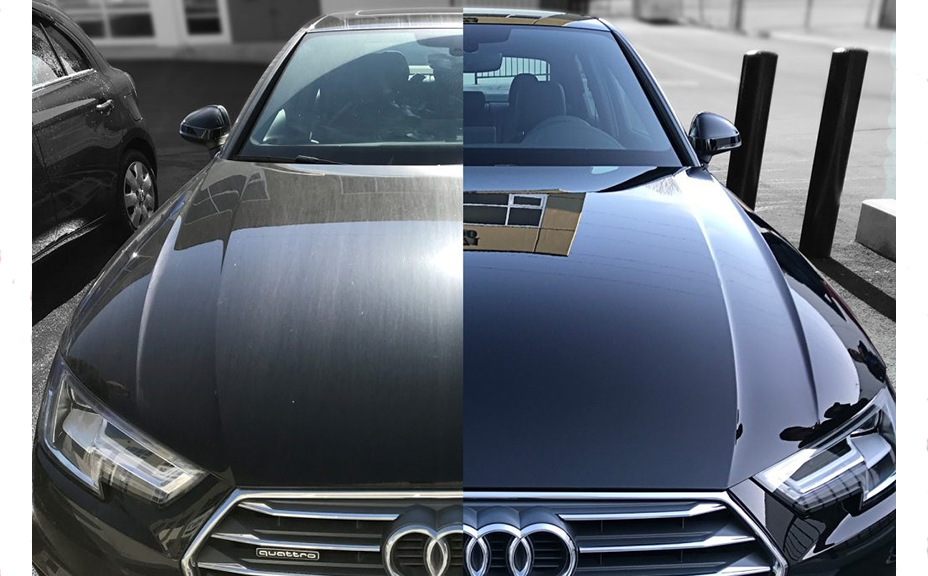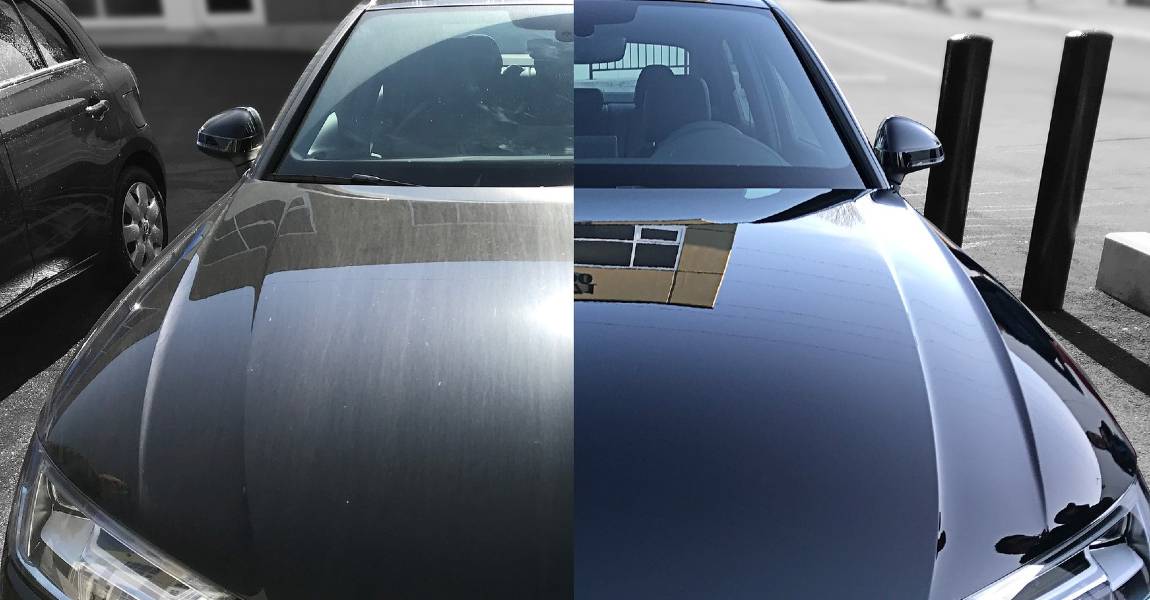Exploring the Scientific Research Behind Car Ceramic Coating and Its Safety Characteristics
The scientific research of car ceramic coating presents an interesting research in innovative vehicle defense. Composed mostly of silicon dioxide and polymers, these finishes create a durable bond with vehicle paint. This communication boosts durability against ecological dangers while offering hydrophobic advantages. The intricacies of just how these layers work and their long-term advantages continue to be less comprehended. Ceramic Coating Newark. Unboxing these details exposes why ceramic coatings are coming to be a preferred option for automobile treatment
What Is Ceramic Coating?
Ceramic coating is a fluid polymer that chemically bonds to the surface area of a car's paint. This advanced safety layer enhances resilience and offers remarkable resistance to environmental variables. Unlike conventional wax or sealants, which give momentary protection, ceramic finishings develop a lasting shield that can hold up against severe conditions such as UV rays, acidic contaminants, and extreme weather. When used appropriately, the coating creates a hydrophobic surface area, triggering water to bead and slide off, which aids in maintaining the vehicle's sanitation. Additionally, it supplies boosted gloss and deepness to the paint, making the car show up more sleek and lively. The application process generally entails thorough surface preparation, consisting of cleansing and polishing, to guarantee peak bonding. Therefore, ceramic coatings are becoming significantly preferred amongst car fanatics and those looking for to shield their financial investments, assuring to maintain the automobile's visual allure while minimizing the frequency of upkeep.
The Structure of Ceramic Coatings
The detailed formula of ceramic finishes mainly is composed of silicon dioxide (SiO2), which is stemmed from natural resources like quartz and sand. This key component supplies the foundation for the coating's durability and safety qualities. In enhancement to SiO2, ceramic finishes typically consist of different polymers and ingredients that enhance adhesion, adaptability, and resistance to environmental elements. These substances function synergistically to produce a robust obstacle against impurities such as dust, chemicals, and UV rays.Furthermore, some formulations incorporate titanium dioxide (TiO2) or various other nanomaterials, which can boost the coating's hydrophobic buildings, leading to enhanced water repellency. The exact make-up can vary greatly among manufacturers, influencing performance and longevity. Eventually, the combination of these elements finishes in a protective layer that not only enhances the visual allure of vehicles but also offers to extend their life expectancy by securing the surface area from prospective damages.
Exactly How Ceramic Coatings Job
Understanding exactly how ceramic finishings function includes exploring their chemical structure, which adds to their protective top qualities. The application process is crucial for achieving suitable results, while longevity and durability aspects establish the coating's effectiveness over time. Together, these components highlight the benefits and efficiency of ceramic coatings for car security.
Chemical Composition Explained
While several car proprietors look for long-lasting security for their automobiles, the chemical make-up of ceramic finishes plays a critical function in their effectiveness. These coatings mostly consist of silicon dioxide (SiO2), which is originated from natural minerals. This compound develops a solid bond with the lorry's paint, creating a resilient, safety layer. In addition, many ceramic layers consist of titanium dioxide (TiO2), improving their hydrophobic homes and resistance to UV rays. The existence of polysiloxanes can better improve versatility and sturdiness. With each other, these elements add to the coating's capacity to drive away water, dust, and pollutants, while also supplying a high-gloss coating. Recognizing this chemical foundation aids car proprietors value the durable security provided by ceramic layers.
Application Refine Overview
Using ceramic finishes involves a thorough process that ensures perfect bonding and protection for the automobile's surface area. Originally, detailed cleansing and purification of the car's exterior are done to eliminate dust, grime, and previous waxes. This step confirms that the surface is without pollutants that could impede bond. Following this, the paint is commonly brightened to boost clarity and eliminate any type of imperfections. Once prepared, the ceramic coating is used in tiny sections utilizing an applicator pad, permitting consistent coverage. The coating is then left to treat, creating a solid chemical bond with the surface area. Proper healing times and conditions are critical, as they validate the coating attains its optimum performance and safety top qualities.
Durability and Durability Factors
Ceramic finishes are made to supply long-lasting protection through their advanced chemical composition, which produces a robust obstacle versus environmental pollutants. The durability of these coatings is affected by elements such as the density of the application, the quality of the item, and the conditions under which the vehicle is exposed. High-quality ceramic finishings can last numerous years, standing up to scrapes, UV rays, and chemical spots. Correct maintenance, consisting of normal washing and routine reapplication, can additionally improve long life. In addition, ecological elements like environment and direct exposure to pollutants can influence the lifespan of the coating. In general, when applied and kept correctly, ceramic coverings provide phenomenal sturdiness, making them a preferred choice for car lovers seeking to maintain their automobile's appearance.
Hydrophobic Features and Water Repellency
Hydrophobic buildings are a trademark of top quality car ceramic coverings, significantly improving the car's surface performance. These layers develop a molecular bond with the car's paint, resulting in a surface that pushes back water properly. When water enters call with a ceramic-coated surface, it beads up and rolls off, minimizing the amount of fluid that remains on the paint. This habits not just contributes to a visually pleasing look yet also lowers the buildup of impurities such as dirt, crud, and roadway salts.The boosted water repellency results in simpler cleansing and upkeep, as much less effort is required to remove unwanted materials. Additionally, the hydrophobic nature of ceramic coverings aids in avoiding water spots, which can mar the finish of uncoated surfaces. On the whole, the unification of hydrophobic homes in ceramic layers plays an important function in keeping the vehicle's immaculate appearance while simplifying upkeep.
Defense Against Scratches and UV Damage
Car ceramic coatings use significant protection against scratches and UV damage. The scrape resistance mechanism creates a sturdy layer that soaks up impacts, while the UV securing benefits aid preserve the car's paint stability over time. Together, these features contribute to a longer-lasting and visually appealing finish.
Scratch Resistance Mechanism
Utilizing innovative technology, ceramic finishes provide a robust shield against scrapes and UV damages, improving the find more information long life and appearance of lorry surface areas. The scrape resistance mechanism of these coverings is attributed to their special molecular structure, which develops a long lasting bond with the lorry's paint. This bond develops a hard, protective layer that can take in influences and stand up to abrasions. In addition, the smooth surface area of the coating minimizes rubbing, making it tough for pollutants to adhere and create scratches. The chemical composition of ceramic finishes typically consists of nanoparticles that enhance the safety layer, more improving its resilience. Subsequently, lorries treated with ceramic finishings show considerably improved scratch resistance compared to typical wax or sealers, making sure an immaculate finish with time.
UV Protecting Conveniences
The protective qualities of ceramic finishings extend beyond scratch resistance to consist of substantial UV shielding benefits. These finishes create a robust obstacle that mirrors hazardous ultraviolet rays, protecting the vehicle's paint and underlying products. Extended exposure to UV radiation can bring about fading, oxidation, and damage of the paint finish. By integrating ceramic coatings, vehicle proprietors can efficiently mitigate these threats, maintaining the visual allure and integrity of their automobiles. Additionally, the UV obstructing properties add to enhanced longevity, lowering the regularity of repainting and upkeep. Eventually, the integration of ceramic coatings supplies an Full Article extensive option for shielding lorries from the destructive results of sun exposure, making certain a continual, lively look with time.
The Durability and Upkeep of Ceramic Coatings

Often Asked Inquiries
Can Ceramic Coating Be Applied to Any Kind of Lorry?
Ceramic coating can be used to various sorts of lorries, consisting of vehicles, vehicles, and bikes. Surface prep work and compatibility with details products are crucial for perfect bond and efficiency of the coating.
Just How Much Does Ceramic Coating Normally Cost?
Ceramic coating usually sets you back between $500 and $2,000, depending upon elements such as car dimension, coating quality, and professional application. The financial investment can provide lasting security and improve the vehicle's appearance with time.

Is Professional Application Needed for Finest Results?
The need of specialist application often depends on wanted results. Experts typically assure proper surface area prep work and application methods, bring about ideal imp source bonding and long life of the coating, which might be testing for unskilled individuals to accomplish.
Can Porcelain Coatings Be Eliminated or Repaired?
Ceramic coverings can be eliminated or fixed, though the procedure might require certain solvents or methods - Ceramic Coating Newark. Correct removal is necessary to prevent damages to the underlying surface, emphasizing the importance of expert aid for perfect results
Just How Does Ceramic Coating Contrast to Conventional Wax?
The contrast between ceramic coating and traditional wax discloses that ceramic coverings supply exceptional sturdiness, boosted defense against environmental contaminants, and longer-lasting shine, while wax calls for more regular application and supplies much less general resistance to damage.